|
|
 |
|
Calanoida ( Order ) |
|
|
|
Diaptomoidea ( Superfamily ) |
|
|
|
Centropagidae ( Family ) |
|
|
|
Centropages ( Genus ) |
|
|
| |
Centropages orsinii Giesbrecht, 1889 (F,M) | |
| | | | | | | Ref.: | | | Giesbrecht, 1892 (p.305, 321, 771, figs.F,M); Giesbrecht & Schmeil, 1898 (p.57, Rem. F,M); Thompson & Scott, 1903 (p.234, 247); Wolfenden, 1905 (1906) (p.1015, figs.F,M); A. Scott, 1909 (p.115, Rem.); Sewell, 1912 (p.315, 353, 362); Pesta, 1912 a (p.46, figs.F,M); 1913 (p.32); Sewell, 1914 a (p.231); Früchtl, 1924 b (p.44); Mori, 1929 (p.174, figs.F); Dakin & Colefax, 1933 (p.205); Farran, 1936 a (p.109); Mori, 1937 (1964) (p.60, figs.F,M); Dakin & Colefax, 1940 (p.91, figs.F,M); Pesta, 1943 (p.25, figs.F,M); Sewell, 1947 (p.163); Chiba & al., 1957 (p.308); Tanaka, 1963 (p.9, Rem.M); Kasturirangan, 1963 (p.31, figs.F,M); Vervoort, 1964 a (p.7, fig.M, Rem.); 1964 b (p.309); Chen & Zhang, 1965 (p.76, figs.F,M); Greenwood, 1977 (p.63, figs.F,M); Chihara & Murano, 1997 (p.767, Pl.82,85: F,M); Mulyadi, 1998 (p.65, figs.F,M, Rem.); Bradford-Grieve & al., 1999 (p.884, 951, figs.F,M); Bradford-Grieve,1999 b (p.139, figs.F,M, figs.180, 192); Al-Yamani & Prusova, 2003 (p.59, figs.F); Conway & al., 2003 (p.119, figs.F,M, Rem.); Mulyadi, 2004 (p.131, figs.F,M, Rem.); Phukham, 2008 (p.71, figs.F,M); Al-Yamani & al., 2011 (p.42, 46, figs.F); El-Sherbiny & Al-Aidaroos, 2015 (p.407, Table 2, Rem.)
| 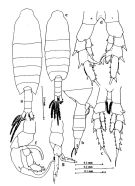 issued from : Mulyadi in The Raffles Bull. Zool., 1998, 46 (1). [Fig.6, p.64]. Female (from Indonesian Seas): habitus (dorsal view); b, Th5 and urosome (lateral view); c, P4; d, P5. Male: e, habitus (dorsal view); f, right P5; g, left P5.
|
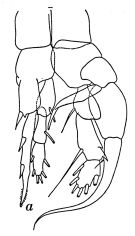 issued from : W. Vervoort in Bull. U.S. natn; Mus., 236. [p.8, Fig.,a]. Male (from Ifaluk Atoll: Caroline Islands): a, P5.
|
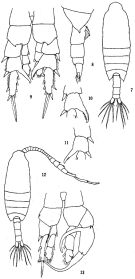 issued from: Q.-c Chen & S.-z. Zhang in Studia Marina Sinica, 1965, 7. [Pl.27, 7-13]. Female (from E China Sea): 7, habitus (dorsal); 8, urosome (lateral right side); 9, P5 (posterior); 10, 2nd exopodal segment of right P5 (anterior); 11, 2nd exopodal segment of left P5 (anterior). Male: 12, habitus (dorsal); 13, P5 (posterior).
|
 issued from : Mori T. in The pelagic Copepoda from the neifhbouring waters of Japan. S. Shirai ed., Tokyo, 1937; 2nd edit, 1964. [Pl.29, Figs.1-6]. Female: 1, habitus (dorsal); 3, P5; 6, genital segment (ventral). Male: 2, P5; 4, right A1; 5, habitus (dorsal).
|
 issued from T. Mori in Zool. Mag. Tokyo, 1929, 41 (486-487). [Pl. VI, Figs. 2-3]. Female (from Chosen Strait, Korea-Japan): 2, habitus (dorsal); 3, right P5.
|
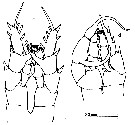 issued from : J.G. Greenwood in Proc. R. Soc. Qd, 1977, 88. [p.62, Fig.5, c-d]. Female (from 27°20'S, 153°15'E): c, P5. Male: d, P5.
|
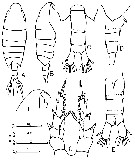 issued from : Y. Al-Yamani, V. Skryabin, A. Gubanova, S. khvorov & I. Prusova in Marine Zooplankton Practical Guide for the Northwestern Arabian Gulf, 2, 2011. [p.46, Fig.163]. Female (from Kuwait): A-B, habitus (dorsal and right lateral, respectively); C, posterior part of prosome and urosome (right lateral); E, urosome (ventral); F, forehead (lateral); G, P5.
|
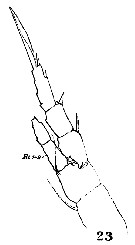 Issued from : W. Giesbrecht in Systematik und Faunistik der Pelagischen Copepoden des Golfes von Neapel und der angrenzenden Meeres-Abschnitte. – Fauna Flora Golf. Neapel, 1892, 19 , Atlas von 54 Tafeln. [Taf.18, Fig.23]. Female: 23, P1 (anterior view).
|
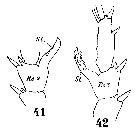 Issued from : W. Giesbrecht in Systematik und Faunistik der Pelagischen Copepoden des Golfes von Neapel und der angrenzenden Meeres-Abschnitte. – Fauna Flora Golf. Neapel, 1892, 19 , Atlas von 54 Tafeln. [Taf.17, Figs.41, 42]. Female: 41, exopodal segment 2 of left P5; 42, exopod of right P5.
|
 Issued from : W. Giesbrecht in Systematik und Faunistik der Pelagischen Copepoden des Golfes von Neapel und der angrenzenden Meeres-Abschnitte. – Fauna Flora Golf. Neapel, 1892, 19 , Atlas von 54 Tafeln. [Taf.18, Figs.2, 14]. Male: 2, right A1 (fused segments 19-21); 14, right A1 (segments 15 and 16).
|
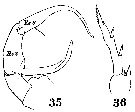 Issued from : W. Giesbrecht in Systematik und Faunistik der Pelagischen Copepoden des Golfes von Neapel und der angrenzenden Meeres-Abschnitte. – Fauna Flora Golf. Neapel, 1892, 19 , Atlas von 54 Tafeln. [Taf.17, Figs.35, 36]. Male: 35, exopod of right P5 (posterior view); 36, exopod of left P5 (posterior view).
|
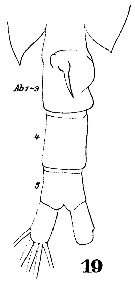 Issued from : W. Giesbrecht in Systematik und Faunistik der Pelagischen Copepoden des Golfes von Neapel und der angrenzenden Meeres-Abschnitte. - Fauna Flora Golf. Neapel, 1892, 19 , Atlas von 54 Tafeln. [Taf.38, Fig.19]. Female: 19, urosome (ventral).
|
 Issued from : W. Giesbrecht in Systematik und Faunistik der Pelagischen Copepoden des Golfes von Neapel und der angrenzenden Meeres-Abschnitte. - Fauna Flora Golf. Neapel, 1892, 19 , Atlas von 54 Tafeln. [Taf.38, Fig.12]. Male: 12, habitus (dorsal).
|
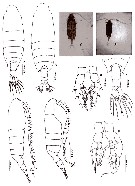 issued from : N. Phukham in Species diversity of calanoid copepods in Thai waters, Andaman Sea (Master of Science, Univ. Bangkok). 2008. [p.153, Fig.27]. Female (from W Malay Peninsula): a, habitus (dorsal); b, same (lateral); c, urosome; d, P5. Male: e, habitus (dorsal); f, same (lateral); g, P5. Body length after the drawings: F = 1.400 mm; M = 1.283 mm.
|
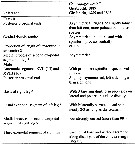 Issued from : M.M. El-Sherbiny & A.M. Al-Aidaroos in Zootaxa, 2015, 3911 (3). [p.408, Table 2]. Female & Male: morphological features. Compare with C. mohamedi and C. halinus.
| | | | | Compl. Ref.: | | | Sewell, 1932 (p.230); C.B. Wilson, 1950 (p.187); Krishnaswamy, 1953 (p.122); Kott, 1957 (p.5, Rem.: p.9); Yamazi, 1958 (p.149, Rem.); Ganapati & Shanthakumari, 1962 (p.8, 15); De Decker & Mombeck, 1964 (p.11); Anraku & Azeta, 1965 (p.13, Table 2, fish predator); Carter, 1977 (1978) (p.36); Hammer & Carleton, 1979 (p.1, 9, swarm); Dessier, 1983 (p.89, Tableau 1, Rem., %); Binet,1984 (tab.2, 3); 1985 (p.85, tab.3); De Decker, 1984 (p.316); Guangshan & Honglin, 1984 (p.118, tab.); Madhupratap & Haridas, 1986 (p.105, tab.1); Dessier, 1988 (tabl.1); Williams D. & al., 1988 (p.580); Othman & al., 1990 (p.561, 563, Table 1); Madhupratap & al., 1991 (p.947, Rem.: p.951); Yoo, 1991 (tab.1); McKinnon, 1991 (p.471); Godhantaraman, 1994 (tab.5, 6, 7); Shih & Young, 1995 (p.69); Ramaiah & al., 1996 (p.3); Ramaiah & Nair, 1997 (tab.1); Sharaf & Al-Ghais, 1997 (tab.1); Hwang & al., 1998 (tab.II); Wong & al, 1998 (tab.2); Achuthankutty & al., 1998 (p.1, Table 2, fig.6, seasonal abundance vs monsoon); El-Serehy, 1999 (p.172, Table 1, occurrence); Dalal & Goswami, 2001 (p.22, fig.2); Greenwood & al., 2002 (p.17, Table 2); Osore & al., 2003 (p.69); Hwang & al., 2003 (p.193, tab.2); Shimode & Shirayama, 2004 (tab.2); Hsiao & al., 2004 (p.325, tab.1); Rezai & al., 2004 (p.489, tab.2); Lo & al.*, 2004 (p.218, fig.6); Yin & al., 2004 (p.3); Kazmi, 2004 (p.228); Hwang & al., 2006 (p.943, tab.I); Dur & al., 2007 (p.197, Table IV); Fernandes, 2008 (p.465, Tabl.2); Ohtsuka & al., 2008 (p.115, Table 5); Tseng L.-C. & al., 2008 (p.46, table 2, abundance vs moonsons, table 3: indicator species); Rakhesh & al., 2008 (p.154, abundance vs stations); Hsiao S.H. & al., 2011 (p.475, Appendix I): as Cen. orsinis, lapsus calami); Maiphae & Sa-ardrit, 2011 (p.641, Table 2); Kâ & Hwang, 2011 (p.155, Table 3: occurrence %); Pillai H.U.K. & al., 2011 (p.239, Table 3, vertical distribution); Guo & al., 2011 (p.567, table 2, indicator); Tseng L.-C. & al., 2011 (p.47, Table 2, occurrences vs mesh sizes); Saitoh & al., 2011 (p.85, Table 4, 5); Naz & al., 2012 (p.61, Table 4, relative abundance); Johan & al., 2012 (2013) (p.1, Table 1); Tseng & al., 2012 (p.621, Table 3: abundance); Tseng & al., 2013 (p.507, seasonal abundance); Jagadeesan & al., 2013 (p.27, Table 3, 4, 5, 6, fig.11, seasonal abundance); Rakhesh & al., 2013 (p.7, Table 1, abundance vs stations); Anjusha & al., 2013 (p.40, Table 3, abundance & feeding behavior); Hwang & al., 2014 (p.43, Appendix A: seasonal abundance); Nakajima & al., 2015 (p.19, Table 3: abundance); Abo-Taleb & Gharib, 2018 (p.139, Table 5, occurrence %). | | | | NZ: | 8 | | |
|
Distribution map of Centropages orsinii by geographical zones
|
| | | | | | | | |  issued from : C.T. Achuthankutty, N. Ramaiah & G. Padmavati in Pelagic biogeography ICoPB II. Proc. 2nd Intern. Conf. Final report of SCOR/IOC working group 93, 9-14 July 1995. Workshop Report No. 142, Unesco, 1998. [p.8, Fig.6]. issued from : C.T. Achuthankutty, N. Ramaiah & G. Padmavati in Pelagic biogeography ICoPB II. Proc. 2nd Intern. Conf. Final report of SCOR/IOC working group 93, 9-14 July 1995. Workshop Report No. 142, Unesco, 1998. [p.8, Fig.6].
Salinity ranges for C. orsinii in coastal and estuarine waters of Goa (India).
Shaded area indicates the range of higher abundance. |
| | | | Loc: | | | South Africa (E & W), Durban Bay, Red Sea, Hurghada, G. of Aden, Arabian Sea, Arabian Gulf, UAE coast, Maldive Is., Laccadive Is. (lagoons), Sri Lanka, Natal, Madagascar (Nosy Bé), Rodrigues Is., Seychelles, Indian, Karashi coast, India (W, S, Bombay, Goa, Madras, G. of Mannar, Palk Bay, Burhabalanga estuary, Godavari region, Kakinada Bay), Bay of Bengal, Burma (coast), Andaman Sea (Barren Island), W Malay Peninsula (Andaman Sea), Thailand, Straits of Malacca, Indonesia-Malaysia, Indonesian Seas, Bintulu coast, Viet-Nam (Cauda Bay), Hainan (Sanya Bay), China Seas (Yellow Sea, East China Sea, South China Sea), Taiwan (E, SW, N, Danshuei Estuary, NE), S Korea, Japan (Nagazaki, Tanabe Bay), Palau Is., Pacif. (W equatorial), Australia (SE, Great Barrier, Brisbane River estuary, Moreton Bay, Shark Bay, G. of Carpentaria), New Caledonia, Caroline Is., Fidji Is., Marshall Is. | | | | N: | 98 (Atlant.: 1; Red Sea: 3; Indian: 42; Indonesia-Malaysia: 8; Pacif.: 44) | | | | Lg.: | | | (26) M: 1,48; (34) F: 1,56-1,2; M: 1,38-1,2; (47) F: 1,6-1,5; M: 1,3-1,25; (78) F: 1,7; M: 1,54; (104) F: 1,7; M: 1,3; (290) F: 1,65-1,4; M: 1,45-1,4; (359) M: 1,11; (776) F: 1,6-1,4; M: 1,3-1,25; (795) F: 1,6; M: 1,3; (991) F: 1,4-1,6; M: 1,25-1,3; (1085) F: 1,61; (1122) F: 1,55; M: 1,3; {F: 1,20-1,70; M: 1,11-1,54} | | | | Rem.: | epipelagic.
For Greenwood (1977, p.63 ) this species, like C. furcatus, is a warm water epiplanktonic form found in both neritic and oceanic waters; the Moreton bay specimens generally were taken in conditions of high salinity (36.69-32.20 p.1000! and temperature (27.0-15.3°C). Although never a dominant, the relatively large size makes their biomass significant in the plankton. After Mulyadi (2004, p.131) this species resembles C. kroyeri.
For El-Sherbiny & Al-Aidaroos (2015, p.407) C. orsinii constitutes with C. halinus and C. mohamedi a ''orsinii'' species-group, members of which share the following features: 1- posterior corners of both sexes weakly pointed; 2- P1 to P3 with 2-segmented endopods, whilst 3-segmented endopods are retained on legs P4 and P5; 3- female P5 possess a relatively short medial process on the 2nd exopodal segment with bilateral serration along the distal part of the lateral margin; 4- male left P5 consists of 2-segmented exopod (ancestral segments 2 and 3 fused), with the 2nd segment being fused to a relatively long bilaterally serrated distal spine; 5- male right P5 with 2nd exopodal segment has short seta at the distolateral corner and relatively short medial process slightly increasing the length of the 2nd exopodal segment; 6- male right P5 with 2nd exopodal segment curved and armed with a slender seta medially close to the basal articulation.
See in DVP Conway & al., 2003 (version 1) | | | Last update : 20/06/2020 | |
|
|
 Any use of this site for a publication will be mentioned with the following reference : Any use of this site for a publication will be mentioned with the following reference :
Razouls C., Desreumaux N., Kouwenberg J. and de Bovée F., 2005-2025. - Biodiversity of Marine Planktonic Copepods (morphology, geographical distribution and biological data). Sorbonne University, CNRS. Available at http://copepodes.obs-banyuls.fr/en [Accessed October 14, 2025] © copyright 2005-2025 Sorbonne University, CNRS
|
|
 |
 |


















